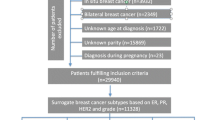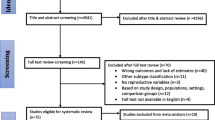Abstract
Objective: To evaluate the potential etiologic heterogeneity of breast cancer by examining whether associations with reproductive and other personal characteristics differed by p53 protein expression status. Methods: Data from the Carolina Breast Cancer Study, a population-based, case–control study of 861 cases and 790 controls, were utilized. Immunohistochemical staining for the p53 protein was performed on 638 archived tumor specimens; 46% of cases were classified as p53+. Two separate unconditional logistic regression models were used to calculate odds ratios (OR) and 95% confidence intervals (CI) for p53+ and p53− breast cancer relative to controls for reproductive and other personal characteristics. Analyses were performed separately for younger (≤45 years) and older (>45 years) women. Results: Risk factor profiles largely overlapped for p53+ and p53− breast cancer, with the exception of oral contraceptive (OC) use among younger women and a family history of breast cancer. Prolonged OC use was more strongly associated with p53+ breast cancer [OR 3.1 (95% CI: 1.2–8.1) than p53− breast cancer (OR 1.3 (95% CI: 0.6–3.2)] among younger women only. A first-degree family history of breast cancer was associated with p53+ breast cancer among younger women [OR 1.5 (95% CI: 1.0–2.2)] and older women [OR 1.4 (95% CI: 0.9–2.3)], but not p53− breast cancer in either age-group. Conclusions: These results provide little evidence of breast cancer heterogeneity as classified by p53 expression status. However, although not statistically significant, OC use among younger women and family history of breast cancer may operate through a pathway involving p53 alterations to increase risk of breast cancer.
Similar content being viewed by others
References
Kelsey JL, Gammon MD, John EM (1993) Reproductive factors and breast cancer. Epidemiol Rev 15: 36-47.
Hall IJ, Newman B, Millikan RC, Moorman PG (2000) Body size and breast cancer risk in black women and white women: the Carolina Breast Cancer Study. Am J Epidemiol 151: 754-764.
Hunter DJ, Willett WC (1993) Diet, body size, and breast cancer [Review]. Epidemiol Rev 15: 110-132.
Feigelson HS, Henderson BE (1996) Estrogens and breast cancer: commentary. Carcinogenesis 17: 2279-2284.
Preston-Martin S, Pike MC, Ross RK, Jones PA, Henderson BE (1990) Increased cell division as a cause of human cancer. Cancer Res 50: 7415-7421.
Yager JD, Liehr JG (1996) Molecular mechanisms of estrogen carcinogenesis. Annu Rev Pharacol Toxicol 36: 203-232.
Henderson BE, Feigelson HS (2000) Hormonal carcinogenesis. Carcinogenesis 21(3): 427-433.
Service RF (1998) New role for estrogen in cancer? Science 279: 1631-1633.
DeVita VT Jr, Hellman S, Rosenberg SA (1997) Cancer, Principles and Practice of Oncology. Philadelphia: J. P. Lippincott.
Weiss NS, Liff JM (1983) Accounting for the multicausal nature of disease in the design and analysis of epidemiologic studies. Am J Epidemiol 117: 14-18.
Potter JD, Cerhan JR, Sellers TA, et al. (1995) Progesterone and estrogen receptors and mammary neoplasia in the Iowa Women's Health Study: how many kinds of breast cancer are there? Cancer Epidemiol Biomarkers Prev 4: 319-326.
Huang WY, Newman B, Millikan RC, Schell MJ, Hulka BS, Moorman PG (2000) Hormone-related factors and risk of breast cancer in relation to estrogen receptor and progesterone receptor status. Am J Epidemiol 151: 703-714.
Olsson H, Borg A, Ferno M, Ranstam J, Sigurdsson H (1991) HER-2/neu and INT2 proto-oncogene amplification in malignant breast tumors in relation to reproductive factors and exposure to exogenous hormones. J Natl Cancer Inst 83: 1483-1487.
Gammon MD, Hibshoosh H, Terry MB, et al. (1999) Oral contraceptive use and other risk factors in relation to HER-2/neu overexpression in breast cancer among young women. Cancer Epidemiol Biomarkers Prev 8: 413-419.
Huang W-Y, Newman B, Millikan RC, et al. (2000) Risk of breast cancer according to the status of HER-2/neu oncogene amplification. Cancer Epidemiol Biomarkers Prev 9: 65-71.
Vogelstein B, Kinzler KW (1993) The multistep nature of cancer. TIG 9: 138.
Lane D (1998) The promise of molecular oncology. Lancet 351(Suppl 2): SII17-SII20.
Greenblatt MS, Bennett WP, Hollstein M, Harris CC (1994) Mutations in the p53 tumor suppressor gene: clues to cancer etiology and molecular pathogenesis. Cancer Res 54: 4855-4878.
Harris CC (1996) p53: at the crossroads of molecular carcinogenesis and molecular epidemiology. J Investig Dermatol Symp Proc 1: 115-118.
Olivier M, Hainaut P (2001) TP53 mutation patterns in breast cancers: searching for clues of environmental carcinogenesis. Semin Cancer Biol 11: 353-360.
Yandell DW, Thor AD (1993) p53 analysis in diagnostic pathology. Biologic implications and possible clinical applications. Diagn Mol Pathol 2: 1-3.
Tsuda H, Hirohashi S (1994) Association among p53 gene mutation, nuclear accumulation of the p53 protein and aggressive phenotypes in breast cancer. Int J Cancer 57: 498-503.
van der KK, Rookus MA, Peterse HL, van Leeuwen FE (1996) p53 protein overexpression in relation to risk factors for breast cancer. Am J Epidemiol 144: 924-933.
Gammon MD, Hibshoosh H, Terry MB, et al. (1999) Cigarette smoking and other risk factors in relation to p53 expression in breast cancer among young women. Cancer Epidemiol Biomarkers Prev 8: 255-263.
Newman B, Moorman PG, Millikan R, et al. (1995) The Carolina breast cancer study: integrating population-based epidemiology and molecular biology. Breast Cancer Res Treat 35: 51-60.
Aldrich TE, Vann D, Moorman PG, Newman B (1995) Rapid reporting of cancer incidence in a population-based study of breast cancer: one constructive use of a central cancer registry. Breast Cancer Res Treat 35: 61-64.
Weinberg CR, Sandler DP (1991) Randomized recruitment in case-control studies. Am J Epidemiol 134: 421-432.
Moorman PG, Newman B, Millikan R, Tse C-KJ, Sandler DP (1999) Participation rates in a case-control study: the impact of age, race and race of interviewer. Ann Epidemiol 9: 188-195.
Millikan R, Pittman G, Newman B, et al. (1998) Cigarette smoking, N-acetyltransferases 1 and 2, and breast cancer risk. Cancer Epidemiol Biomarkers Prev 7: 371-378.
Furberg H, Newman B, Moorman P, Millikan R (1999) Lactation and breast cancer risk. Int J Epidemiol 28: 396-402.
Moorman PG, Millikan RC, Newman B (2001) Oral contraceptives and breast cancer among African-American women and white women. J Natl Med Assoc 93: 329-334.
Dressler LG, Geradts J, Burroughs M, Cowan D, Millikan RC, Newman B (1999) Policy guidelines for the utilization of formalin-fixed, paraffin-embedded tissue sections: the UNC SPORE experience. University of North Carolina Specialized Program of Research Excellence. Breast Cancer Res Treat 58: 31-39.
Sas Institute Inc. (1988) SAS/STAT User's Guide, Release 6.03 Edition. Cary, NC: SAS Institute Inc.
Yarbro JW, Page DL, Fielding LP, Partridge EE, Murphy GP (1999) American Joint Committee on Cancer prognostic factors consensus conference. Cancer 86: 2436-2446.
Begg CB, Zhang ZF (1994) Statistical analysis of molecular epidemiology studies employing case-series. Cancer Epidemiol Biomarkers Prev 3: 173-175.
Furberg H, Millikan RC, Geradts J, et al. (2002) Environmental exposures in relation to breast cancer characterized by p53 expression. Cancer Epidemiol Biomarkers Prev 11: 829-835.
De Benedetti VM, Welsh JA, Yu MC, Bennett WP (1996) p53 mutations in hepatocellular carcinoma related to oral contraceptive use. Carcinogenesis 17: 145-149.
Armes JE, Trute L, White D, et al. (1999) Distinct molecular pathogeneses of early-onset breast cancers in BRCA1 and BRCA2 mutation carriers: a population-based study. Cancer Res 59: 2011-2017.
Crook T, Crossland S, Crompton MR, Osin P, Gusterson BA (1997) p53 mutations in BRCA1-associated familial breast cancer. Lancet 350: 638-639.
Glebov OK, McKenzie KE, White CA, Sukumar S (1994) Frequent p53 gene mutations and novel alleles in familial breast cancer. Cancer Res 54: 3703-3709.
Shields PG, Harris CC (1991) Molecular epidemiology and the genetics of environmental cancer. JAMA 266: 681-687.
Chappuis PO, Kapusta L, Begin LR, et al. (2000) Germline BRCA1/2 mutations and p27(Kip1) protein levels independently predict outcome after breast cancer. J Clin Oncol 18: 4045-4052.
Greenblatt MS, Chappuis PO, Bond JP, Hamel N, Foulkes WD (2001) TP53 mutations in breast cancer associated with BRCA1 or BRCA2 germ-line mutations: distinctive spectrum and structural distribution. Cancer Res 61: 4092-4097.
Abbott DW, Thompson ME, Robinson-Benion C, Tomlinson G, Jensen RA, Holt JT (1999) BRCA1 expression restores radiation resistance in BRCA1-defective cancer cells through enhancement of transcription-coupled DNA repair. J Biol Chem 274: 18808-18812.
Vahakangas KH, Samet JM, Metcalf RA, et al. (1992) Mutations of p53 and ras genes in radon-associated lung cancer from uranium miners. Lancet 339: 576-580.
Elledge RM, Allred DC (1998) Prognostic and predictive value of p53 and p21 in breast cancer. Breast Cancer Res Treat 52: 79-98.
Author information
Authors and Affiliations
Corresponding author
Rights and permissions
About this article
Cite this article
Furberg, H., Millikan, R., Geradts, J. et al. Reproductive factors in relation to breast cancer characterized by p53 protein expression (United States). Cancer Causes Control 14, 609–618 (2003). https://doi.org/10.1023/A:1025682410937
Issue Date:
DOI: https://doi.org/10.1023/A:1025682410937




